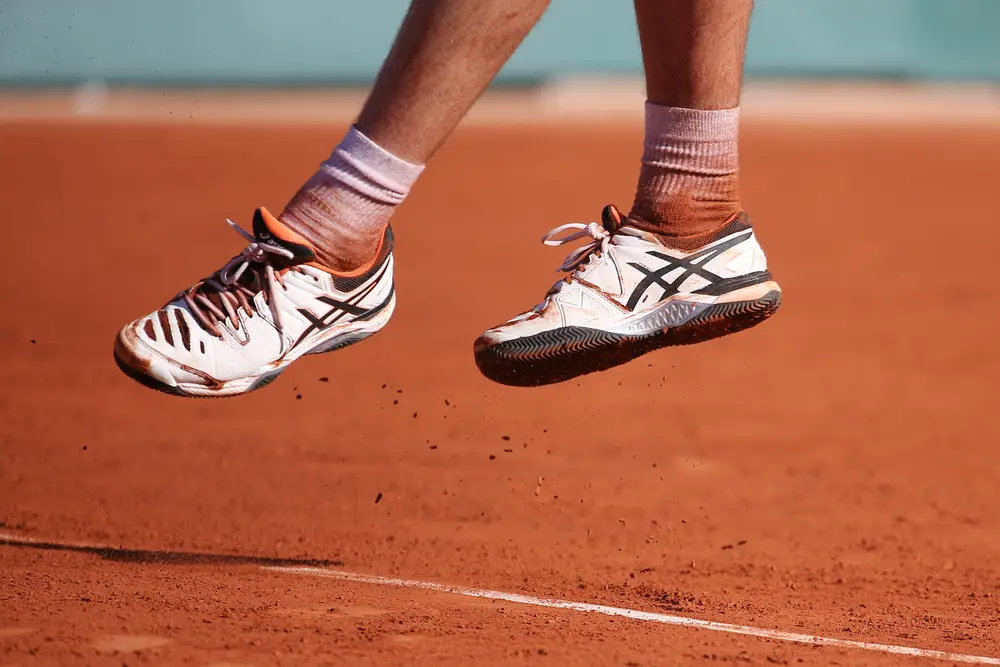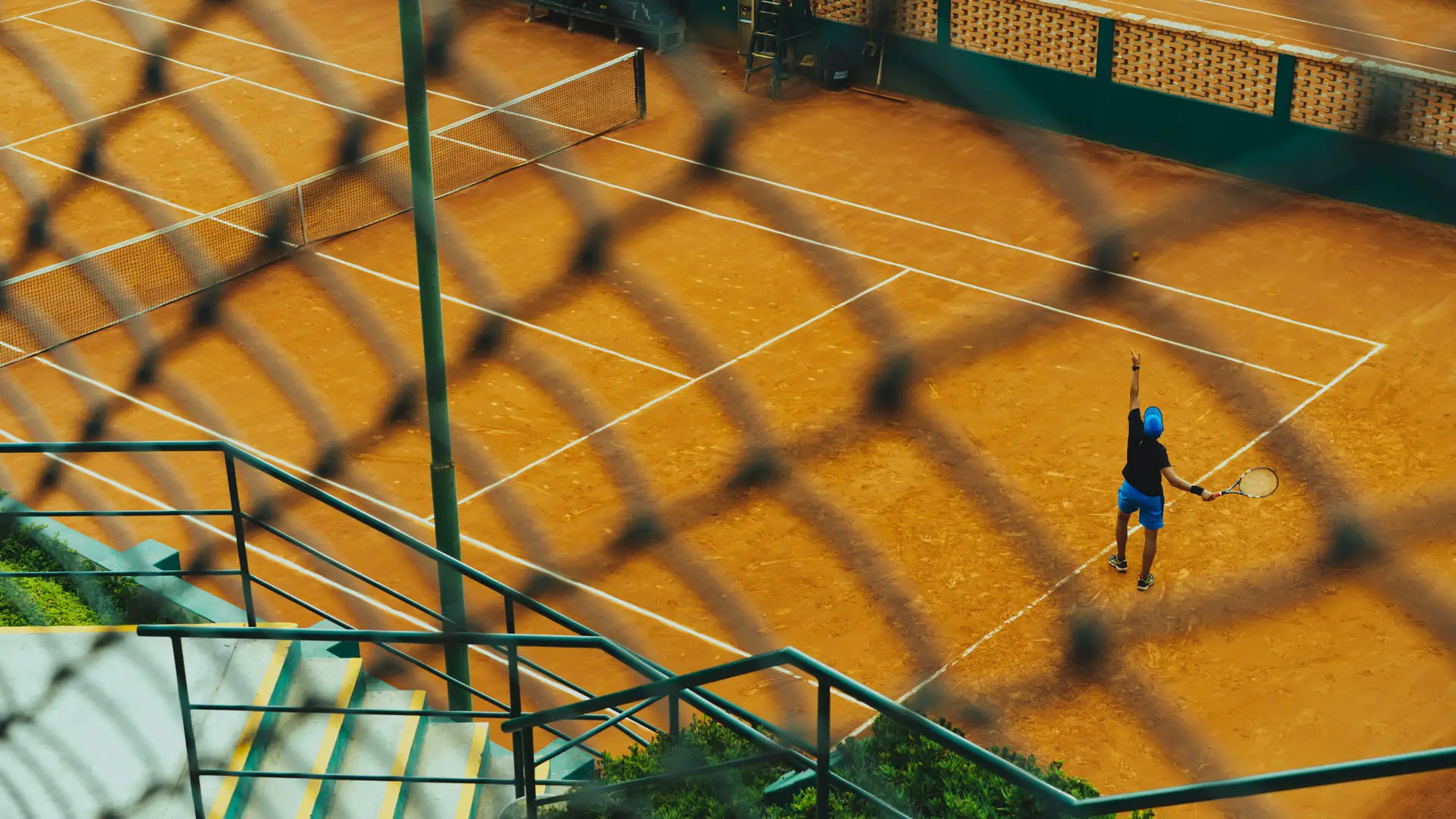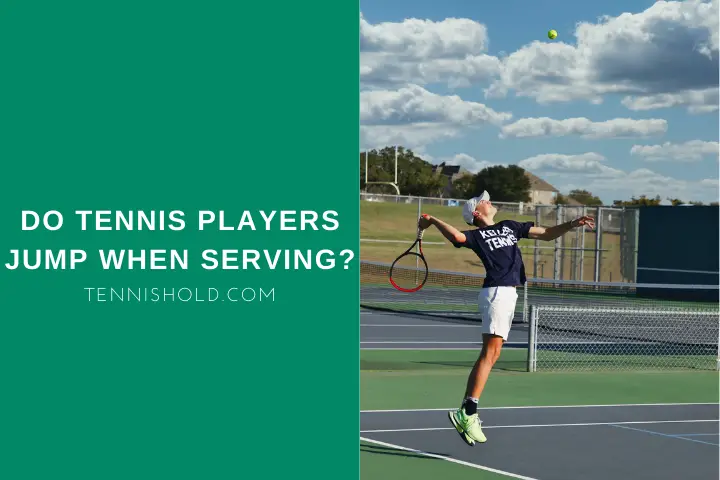Do you know why taller players can serve faster than others in tennis?
The main reason is that they can contact the ball from a higher angle than most.
Without standing on anything, a taller person will always be able to reach higher.
Is there anything shorter players can do to get a higher angle on their serve? It is not practical to bring a ladder or some other type of platform to court.
What about jumping? Can tennis players jump when serving, and do they?
Virtually all tennis players on the professional tour will jump up when they serve. They do this to make sure they can contact the ball as high as possible. When they contact high, it is easier to come down at the ball and thus hit more aggressively.
In this piece I will discuss:
- The rules on jumping in tennis
- If jumping up to serve will make the ball go faster
- Why some players don’t jump up to serve
When I think of the word jump, I think most people jump up and towards something, sometimes over a gap.
It’s better to think of the jump in tennis more as a launch up.
Is Jump Serve In Tennis Legal?

The only time the word jump is used in the ITF rules of tennis is to describe a situation in which a player leaps over the net.
The question asks if a player is allowed to jump over the net and onto the opponent’s side if a point is in play.
The answer on this occasion is no. They have this rule not because they want to prohibit people from jumping.
The rule is in place to stop people from crossing into the opponent’s side of the court. It doesn’t matter if it is a jump or you walk round the net.
When the ball is in play, there is nothing to stop you from jumping.
If you are hitting a forehand and want to jump up as or after you hit it, you are welcome to.
Most players will find it more challenging jumping while hitting a ball. It’s tough because you will not be balanced, and you also have to time when to leap up.
Gael Monfils is famous for his jumping groundstrokes.
The most common time you will see a player jumping is when they serve.
As mentioned earlier, players jump up when they serve so that they can contact the ball at a higher angle.
By most standards, John Isner is a giant, measuring 6 feet and 10 inches (2.08 meters).
Even though he can get a nice angle without jumping, he will get an even more extreme angle when jumping up.
Another form of jumping you may have seen in tennis is on a grass court. However, perhaps diving is a better word to use.
On grass courts, it is not uncommon to see players jump and then dive for a ball that is hard to reach.
This will usually happen when the player is at the net. As you come closer to the net, your reach is reduced. If the opponent hits a good angle, you may benefit from diving.
For safety reasons, I wouldn’t recommend doing it on any other surface.
Would Jump Serve Make The Ball Go Faster?

Jumping up in itself is not going to make the ball go faster. However, there is a rather tall guy I coach who likes to jump up when he serves.
I have explained to him that he will be able to contact the ball at a much higher angle than anyone else because of his height.
If a tall person can properly utilize the jump in the serve, they develop a real weapon.
No matter how hard someone who is 5 feet and 7 inches (1.7 meters) tries, their maximum reach will never be the same as John Isner’s.
What makes it go fast is hitting with more velocity. As the player can come down on the ball more, they can hit it faster.
The racket is coming from on top of the ball (and slightly behind), and the angle is thus more extreme.
Every player (male) in the top 10 ranking for fastest serve ever hit is over 6 feet tall.
The shortest players in this category are Andy Roddick, Ryan Harrison, and Feliciano Lopez. All three of them measure 6 feet and 2 inches (1.88 meters).
While 6 feet and 2 inches are not the highest in terms of tennis players, it is definitely above average.
Combine height with a good launch up to the ball, and you could have a very powerful serve.
Even though almost all professional players jump up to serve, it doesn’t mean it is a good idea for everyone.
For some people, it will be too tough to coordinate a jump in addition to the other things needed on serve.
If a player is not able to accurately time the jump, it is not going to make the ball go faster. Most beginner players will not be able to serve over arm and jump up in combination.
Why Don’t Tennis Players Jump Serve?

Even if most professional players choose to jump up to serve, most standard club players do not. Why is this?
As mentioned previously, serve is a pretty tough shot on its own. However, once you start adding a jump into the mix, it is just one more thing you need to think about.
Most people struggle with that coordination, and it is just easier for them to serve with both feet on the ground.
Control plays a part too. But, most will feel that they can guide their racket better when on the ground.
As both feet are on the ground, they can focus more of their attention on where the strings are pointing and the direction of the racket.
If you compare serving in tennis to volleyball, it is a little different. In volleyball, you can serve anywhere you want, as long as the ball lands (or would have landed) in the play area.
The target zone in tennis is much smaller. It must go into the service box.
As the target is small, it is easier (as a progression) to keep the feet on the ground.
Many coaches use a progressive method of teaching the serve because of its complexity.
Some will begin with players standing right up against the net, front on, and getting them to high-five the ball with their hand.
Most players who do a “jump serve” will begin by bending their knees after releasing the ball.
After the knee bend and as the ball reaches the pinnacle of the toss, they will leap to the ball. They will land on their left foot for a right-hander, usually inside the court.
Also read: Can Tennis Player Jump Over The Net?
Final Words
Jumping into the serve is not something I recommend beginners try. But, unfortunately, it’s also something many intermediate players aren’t ready for either.
When I see a player has gotten confident with their serve, I may begin to introduce them to the launch up.
As a coach, the most important thing when working on serve for beginners is giving them the confidence to get the ball over and in.
If a jump will reduce that confidence, then the player is not ready yet.
Do you lift off the ground when you serve?
I remember I played a couple of years before I started to launch up to the ball. It gave me the ability to hit with way more speed.

